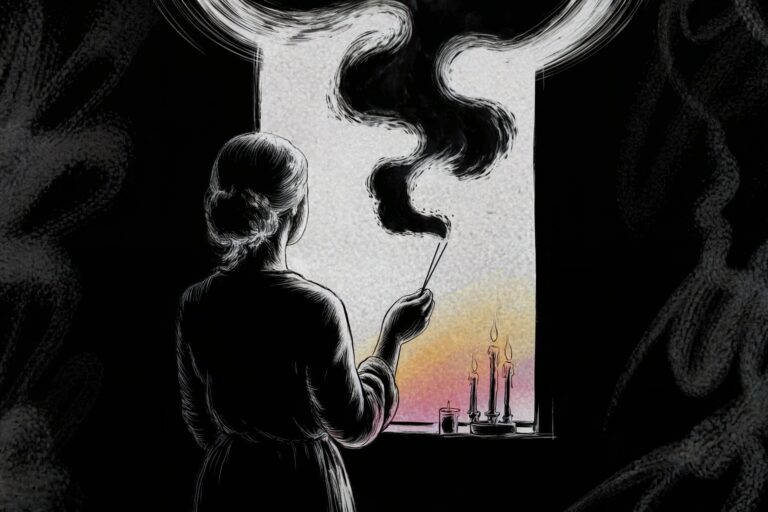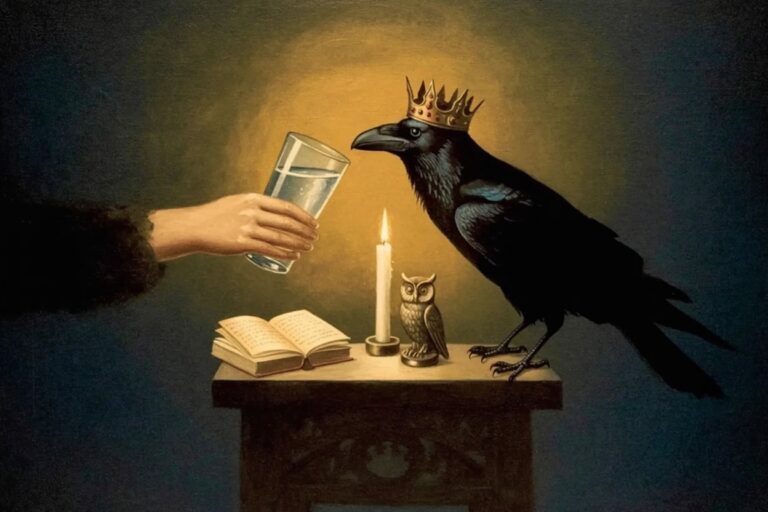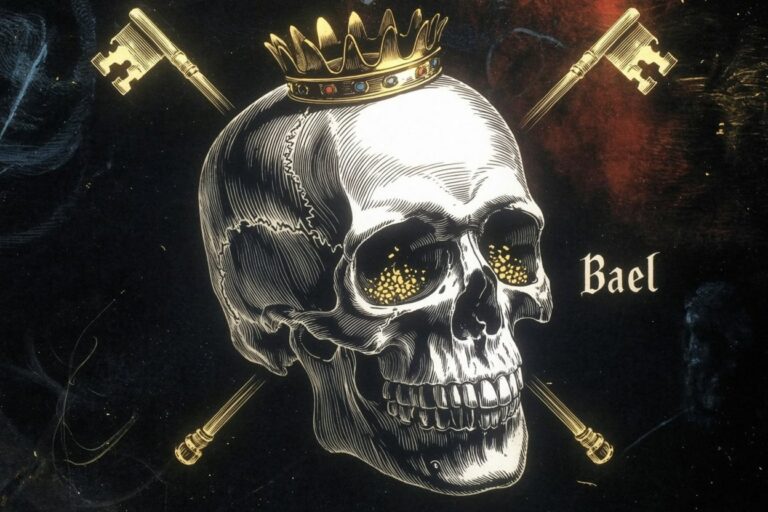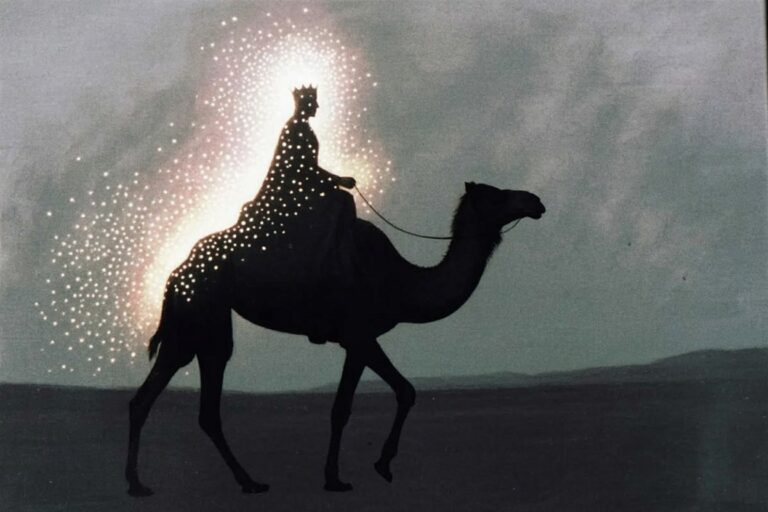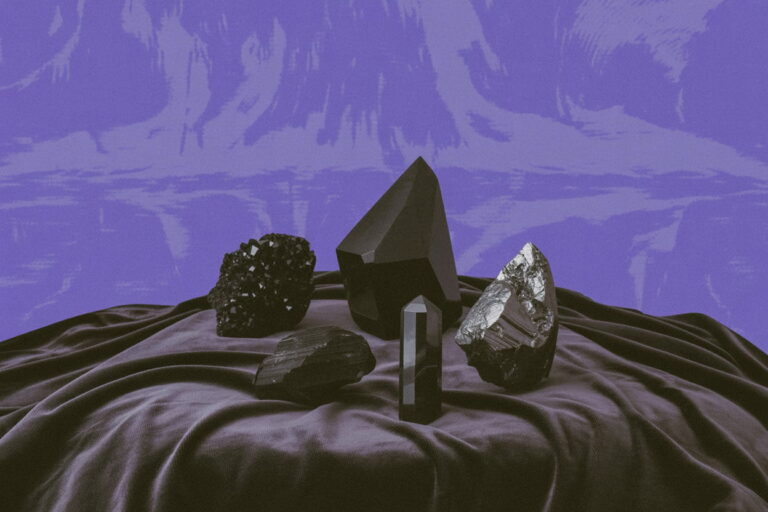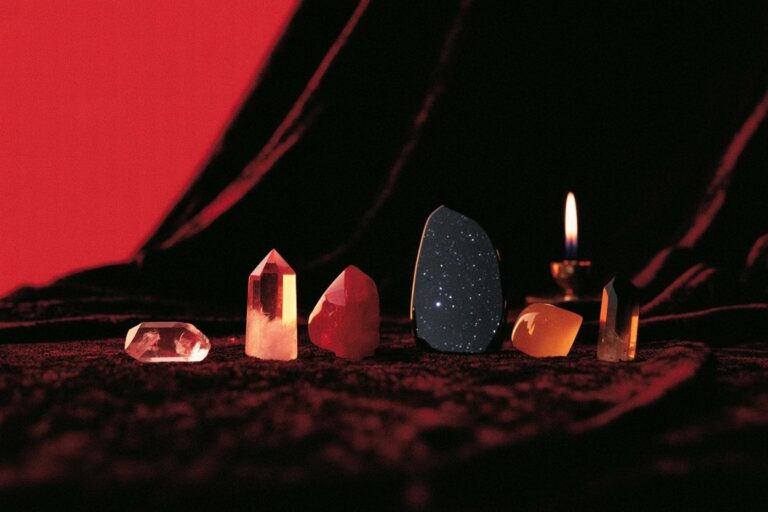Astarte: How to Connect with the Queen of Heaven
Please note that posts on this site may contain affiliate links
Before sunrise, Venus rises in the eastern sky. Ancient Phoenician sailors watched this same light and saw Astarte, their Queen of Heaven, announcing the dawn. The planet hasn’t changed. Your neurological response to that liminal moment between dark and light hasn’t changed either. This is where you meet her.
Astarte refuses the boxes we try to put goddesses in. She won’t separate love from war, beauty from battle, sexuality from sovereignty. The Canaanites and Phoenicians worshipped her as both the goddess of fertility and the goddess who rode into battle, because they understood something we’re still relearning: these forces aren’t opposites. They’re facets of the same power that creates, destroys, and transforms life.
- Who Astarte Was (And Still Is)
- The Venus Connection: Why This Correspondence Works
- Her Symbols Form a System
- Building Her Correspondences Into Practice
- Setting Up Your Altar Space
- Friday Night Ritual for First Contact
- Traditional and Modern Offerings
- Working With Her Through Planetary Hours
- Astarte in Contemporary Practice
- Tarot Cards That Carry Her Energy
- When Venus Rises Tonight
Who Astarte Was (And Still Is)
Astarte emerged in the ancient Near East as one of the most powerful deities of Canaan and Phoenicia. Archaeological evidence from Ugarit, Sidon, and Tyre shows her temples dominated Mediterranean port cities. The Phoenicians, master sailors and colonists, carried her worship across the sea. You find her traces in Cyprus, Malta, Sicily, and as far as the Iberian coast.
Her power threatened the emerging monotheistic religions. The Hebrew Bible calls her Ashtoreth and records how Solomon built her a temple near Jerusalem. Josiah later destroyed it during his religious reforms. But here’s what matters: they destroyed her temple because people kept going there. Her pull was strong enough that it took political force to suppress. The Jewish Encyclopedia documents this tension, showing how “the abomination of the Sidonians” kept drawing worshippers despite official condemnation.
When Greek culture absorbed her, she split. Aphrodite took her love and beauty aspects. Artemis absorbed her connection to wilderness and hunting. This division reflects Greek thinking more than Astarte’s nature. The original goddess held all these domains simultaneously because ancient Near Eastern cultures recognized them as interconnected.

The Venus Connection: Why This Correspondence Works
Venus (the planet) and Astarte share more than poetic association. The astronomical reality creates the magical link.
Venus appears as both morning and evening star, the brightest object in the sky after the sun and moon. This dual nature mirrors Astarte’s refusal to be singular. She appears at thresholds: dawn and dusk, the liminal moments when perception shifts. Ancient observers tracking Venus noticed its movements correlated with seasonal changes affecting agriculture and fertility. Repeated observation created causal associations in collective consciousness.
When you work with Venus energy now, you’re tapping into thousands of years of humans watching that light and associating it with desire, beauty, and generative power. That’s not metaphor. Repeated cultural practice creates neurological grooves. The correspondence works because collective human experience has wired these associations into how we process meaning.
Venus rules Friday, making it the optimal day for Astarte work. The planetary day system isn’t arbitrary. It follows the Chaldean order, an astronomical observation system that tracked actual celestial movements. When you time rituals to Friday, you’re aligning with observable cosmic patterns and with centuries of practitioners who noticed Friday rituals for love and beauty produced stronger results.
Her Symbols Form a System
Astarte’s symbols aren’t a random collection. They create a coherent sign system where each element reinforces the others.
The lion appears repeatedly in her iconography. Lions hunt. They protect their territory. They embody fierce power that doesn’t apologize. When Phoenician artists depicted Astarte standing on a lion or flanked by lions, they showed her sovereignty. Use lion imagery in ritual when you need her warrior aspect: boundary setting, removing obstacles, claiming power.
The dove sits opposite the lion in symbolic function. Doves carry messages, navigate vast distances to return home, and mate for life. Ancient cultures saw doves as sacred to Venus precisely because they embody relational bonds and directed movement toward desired outcomes. Call on dove energy for love work, reconciliation, or finding your way back to yourself after displacement.
The morning star marks the moment Venus rises before dawn. This isn’t just pretty symbolism. That pre-dawn darkness holds psychological power. Your conscious defenses are lower. You’re more permeable to experience. Ancient priestesses timed rituals to this threshold for good reason. If you want to work with Astarte at her most accessible, set your alarm for before sunrise, go outside, and watch Venus rise.
Bull horns crown her in many representations. Bulls meant agricultural wealth, generative power, and stubborn determination to Near Eastern peoples. The horns signal sovereignty, specifically the kind that comes from controlling resources and fertility. Modern practitioners connect this to financial abundance and creative productivity.
Building Her Correspondences Into Practice
The correspondence system expands from the Venus foundation. Each element connects logically to the next, creating a web of associations your brain recognizes even before you consciously understand why.
Metal: Copper. Venus (the planet) is associated with copper in traditional planetary magic systems. Copper conducts energy. It’s been used in healing and beauty practices across cultures. If you can find a copper bowl for altar offerings or wear copper jewelry during Astarte rituals, you’re adding another sensory layer that reinforces the Venus-Astarte connection.
Color: Green and pink. Not arbitrary. Green signals growth, the color of new life pushing through soil. Pink carries the wavelength associated with soft power, attraction rather than force. These colors trigger specific neurological responses tied to safety, desire, and abundance. Use green or pink candles, altar cloths, or flowers on her altar.
Crystals: Rose quartz, emerald, moonstone. Rose quartz carries the signature pink of Venus energy. Emerald is Venus’s stone in traditional correspondences, associated with Astarte in her beauty and sovereignty aspects. Moonstone bridges to Astarte’s lunar connections, particularly her role as Queen of Heaven (a title linking her to celestial bodies).
Each correspondence reinforces the others. When you combine them (copper bowl, pink candle, rose petals, rose quartz), you’re not just stacking symbols. You’re creating a sensory environment that directs your consciousness toward the frequency associated with Astarte. That’s how correspondences work: through accumulated cultural meaning meeting neurological response.

Setting Up Your Altar Space
Astarte doesn’t require elaborate temple architecture. She responds to intention focused through physical arrangement.
Choose a surface you can dedicate to her. Could be a shelf, a small altar table, a cleared section of your dresser. Place it where you’ll see it daily if possible. Regular visual contact maintains the connection.
Start with her primary symbol: Venus. Find an image of the planet (astronomy photos work) or the Venus symbol (♀). This anchors the altar to the planetary current you’re working with.
Add representations of her dual nature. A dove figure or feather for her love aspect. Something representing strength for her warrior side (a small knife, a lion figurine, an image of a woman in armor). Don’t worry about historical accuracy. What matters is that your unconscious mind recognizes the symbols as marking different facets of power.
Copper if you have it. A copper bowl becomes your offering vessel. No copper? Use what you have. The correspondence enhances the work but isn’t required.
Fresh flowers when possible. Roses are traditional but any beautiful flower honors her. Let them die naturally on the altar, then compost them. This mirrors the cycle of beauty, death, and regeneration she embodies.
A pink or green candle. Light it when you want to open communication. The flame becomes a focal point, a third thing to meditate on that’s neither you nor the goddess but the connection between.
Keep it clean. Dust weekly. Change offerings before they rot. An altar cared for signals continued devotion. A neglected altar signals your attention has moved elsewhere.
Friday Night Ritual for First Contact
Friday evening after sunset marks Venus’s hour. This is optimal timing for initial connection.
Light your candle. If you have incense (rose, jasmine, or any sweet scent), light that too. Stand or sit before the altar. Take three deep breaths, counting to four on each inhale and exhale. This signals your nervous system to shift into receptive mode.
Speak aloud: “Astarte, Queen of Heaven, I call to you. Lady of the morning star, lady of the evening star, I honor you. You who are both fierce and tender, sovereign and sensual, warrior and lover, I seek your presence.”
Adaptations of traditional goddess invocations can guide your wording if you prefer more structure. Or speak from your heart. She responds to sincerity more than formal language.
State what you’re seeking. Be specific. “I want to reclaim my power in relationships.” “I need to integrate my sexuality with my spiritual practice.” “I’m learning to be fierce without losing softness.” Astarte works with wholeness, with the parts of yourself you’ve been told don’t belong together.
Sit in silence for at least five minutes. Watch the candle flame. Don’t expect dramatic visions. Connection often comes as subtle shifts in how you feel, fleeting thoughts that seem to come from outside your usual mental patterns, or simply a sense of presence in the room.
When you feel complete, thank her. “Astarte, Queen of Heaven, thank you for your presence. May your blessings remain.” Let the candle burn down completely if it’s safe to do so, or extinguish it and relight it next Friday.
Traditional and Modern Offerings
Ancient worshippers brought grain, honey, wine, and libations of oil. These offerings made sense in an agricultural economy where food security was tied to divine favor.
Modern offerings can adapt while keeping the essential logic: give something of value that represents abundance and beauty.
Traditional offerings that still work:
- Honey (diluted in water creates a sweet libation you can pour outside)
- Wine or pomegranate juice
- Bread (especially if you bake it yourself)
- Milk mixed with rose water
- Olive oil
Contemporary offerings:
- Quality chocolate (combines sweetness with aphrodisiac properties)
- Beautiful objects (a stone from a meaningful place, a found feather, art you’ve made)
- Actions as offerings: creating something beautiful, standing up for yourself, expressing your sexuality without shame, showing fierce protection for someone you love
- Your time: sitting in silence with her, reading poetry aloud at her altar, dancing
Pour liquid offerings outside onto earth if you can. If not, into a houseplant’s soil or a ritual bowl. Solid offerings can stay on the altar for three days, then be buried or composted.
The offering’s purpose is relationship. You give, establishing reciprocity. This isn’t transaction (do ut des in its crudest form). It’s recognition that power flows when we actively participate in exchange rather than just taking.

Working With Her Through Planetary Hours
The planetary hour system divides day and night into twelve segments each, with each hour ruled by a different planet. Venus hours occur multiple times per day in a rotating pattern.
Calculate Venus hours using a planetary hours calculator (many free ones online). Enter your location and date. The tool shows you when Venus rules each hour.
Plan important Astarte work for these windows: starting new relationships, beauty magic, prosperity rituals, creative projects, sovereignty work. The planetary current running through that hour amplifies magic aligned with Venus’s domains.
The first hour after sunrise on Friday is always Venus’s hour. This is your strongest window for Astarte connection each week. Even five minutes of meditation during this hour creates noticeable shifts.
Astarte in Contemporary Practice
Modern practitioners drawn to Astarte tend to be people tired of spiritual bypassing. They’re done pretending spirituality means never being angry, never wanting sex, never claiming power. They’re reclaiming the kind of divine feminine that ancient peoples actually worshipped: fierce, sexual, beautiful, terrifying, nurturing, sovereign.
Working with Astarte as a solitary practitioner means you don’t need anyone’s permission to honor a goddess who refuses compartmentalization. You don’t need a coven, an initiation, or years of study. You need Venus rising and your willingness to meet her there.
The resurgence of interest in goddesses like Astarte, Hekate, and Lilith signals a collective recognition that the sanitized versions of divine feminine we were offered aren’t enough. We need goddesses who model the full spectrum of power. We need permission to be holy and sexual, spiritual and fierce, beautiful and dangerous.
Astarte gives that permission. She always has.
Tarot Cards That Carry Her Energy
When you want to connect with Astarte through tarot, certain cards embody her aspects:
The Empress (card III) represents abundance, beauty, sensuality, and creative power. This is Astarte in her fertile, generative mode. When this card appears, she’s inviting you to create, to pleasure yourself, to recognize your sovereignty.
The High Priestess (card II) connects to her role as Queen of Heaven, the mysterious feminine wisdom that knows without being taught. This is Astarte as the keeper of secrets, the goddess of the liminal spaces between conscious and unconscious.
Strength (card VIII or XI depending on your deck) shows the union of fierce and tender that defines her. The woman who tames the lion without violence, who holds power through presence rather than force. This is Astarte teaching you how to be powerful without becoming harsh.
Keep these cards on her altar. Meditate on them when you want to understand different facets of her nature. Pull one before a ritual to see which aspect she wants to show you today. If you’re building your tarot collection, choose a deck whose imagery resonates with your understanding of divine feminine power.

When Venus Rises Tonight
Before you build the elaborate altar, before you research every correspondence, before you read another book about goddess worship, do this:
Find out when Venus rises in your location tomorrow morning. Set your alarm for fifteen minutes before. Go outside. Watch the sky.
When you see that bright point of light appearing in the predawn darkness, you’re seeing what Phoenician sailors saw. What temple priestesses saw. What thousands of years of humans recognized as the Queen of Heaven.
That light is real. The planet is real. Your neurological response to liminal threshold moments is real. The correspondence between Venus and desire, beauty, and generative power is real because humans have observed and reinforced that connection across millennia.
Astarte isn’t a metaphor for empowerment. She’s the actual force that moves through your body when you claim your full power. She’s what happens when you stop separating the fierce from the soft, the sexual from the sacred, the beautiful from the deadly.
Go meet her in the morning star. Everything else builds from there.
Herbs: Rose, myrtle, apple. Rose belongs to Venus in every Western magical tradition. The scent alone shifts your nervous system toward relaxation and openness. Myrtle was sacred to both Astarte and Aphrodite, used in ancient love charms and worn by brides. Apple seeds form a pentagram when you cut the fruit crosswise, connecting the apple to the divine feminine across multiple cultures. These are plants whose properties (scent, appearance, traditional use) create the psychological state conducive to Venus work. You can work with dried herb bundles on your altar or burn them as offerings.


